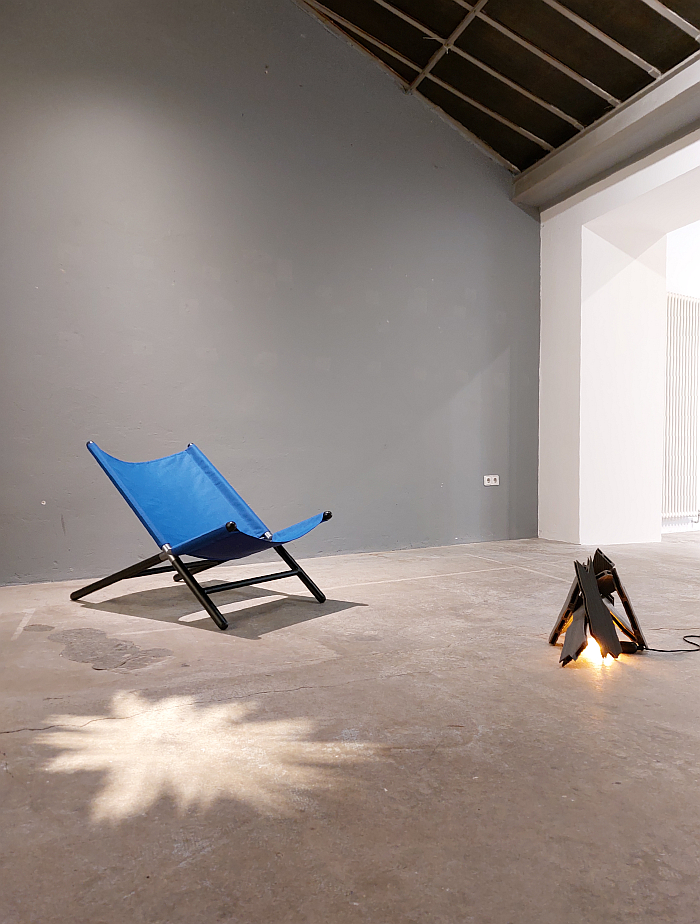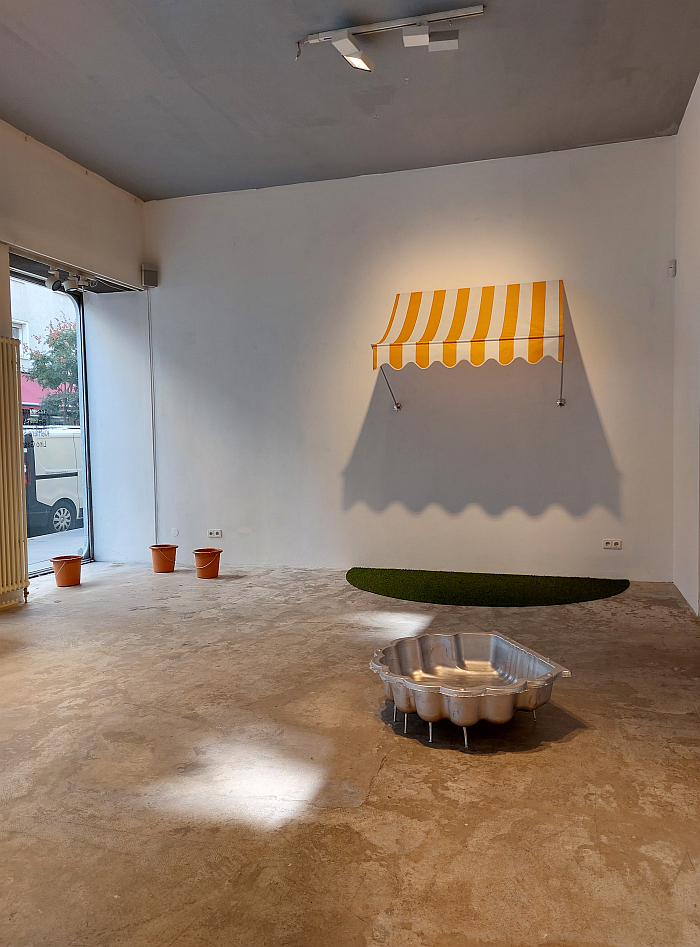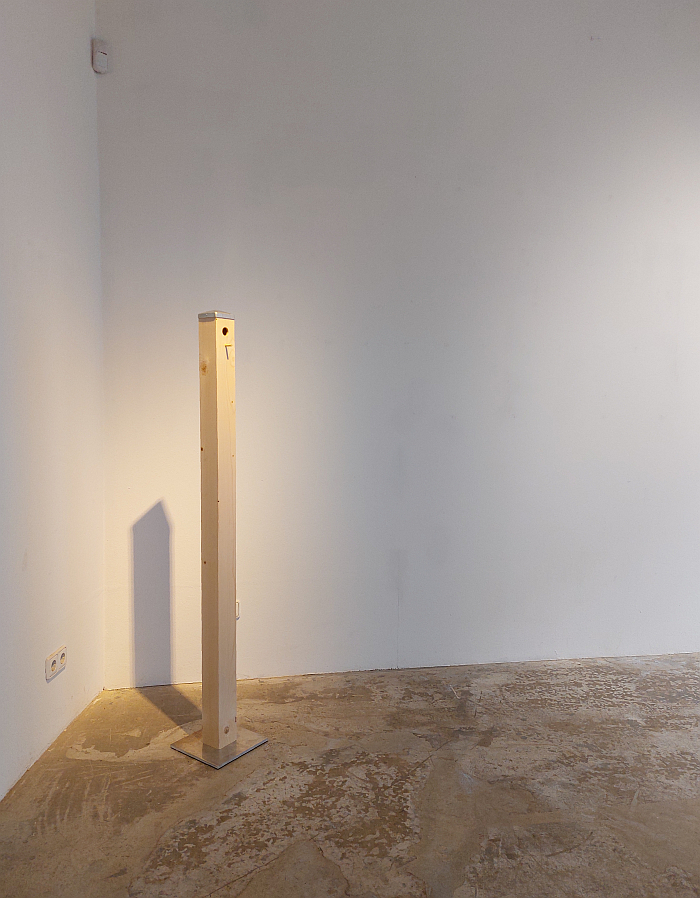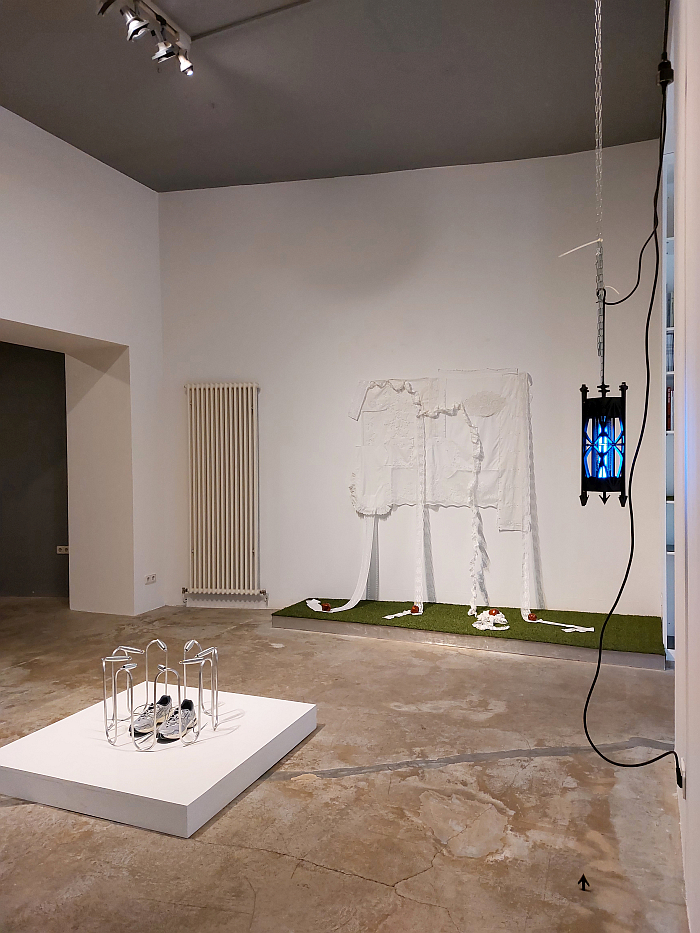Vienna Design Week 2023 Compact: Garten at Galerie Rauminhalt

Stargazer chair by Klemens Schillinger (l) and Campfire by Lino Gasparitsch, as seen at Garten, Galerie Rauminhalt, Vienna Design Week 2023
As noted in our post from Ums Eck – 1 M² by Studio Högl Borowski, Vienna Design Week has always been an event that has taken an interest in Vienna, in the fabric of Vienna, the residents of Vienna and the relationships within the city. Including the many green spaces, or potential, possible, green spaces in the city, such as the Czerninplatz that was the focus of 1 M². With Garten Galerie Rauminhalt expand that vision of urban green spaces from the practical to the conceptual.
A group show by Vienna based collective Temporary.Arrangement Garten presents reflections by the quartet on gardens, human relationships with gardens, relationships of gardens with nature, the creation of gardens, the staging within gardens, gardens as wider metaphors, and as such also allows for some differentiated reflections on that presented in, and the thoughts initiated by, the showcase Of Gardens and People. Designed Nature, Art and Landscape Architecture at the Austrian National Library, Vienna. Whereby we’re certain that wasn’t the intention, but the exchange is pleasing.
Not that the two need be viewed together, but the invitation is very much there. (Or was there depending on when you are reading this) Before going out to explore the green spaces of Vienna.
Presenting a variety of approaches and positions, some very direct such as, for example, Venus by Anna Zimmermann which presents the half sea shell motif much employed in ages past and often found today in cheap children’s plastic monoblock sand pits, as a valuable aluminium object, or Terracotta Bucket by Klemens Schillinger which crafts the familiar plastic bucket in terracotta, and which both thereby play on perceptions, materiality, relationships etc. And do so very satisfyingly and engagingly. While others are more indirect. Or at least were to us, we think in particular of Waves or SPF 30, both by Zimmermann & Schillinger, where we believe we’re approaching an understanding, but give us a little more time before asking us for an answer.
As ever, a showcase such as Garten never is, never should be, a competition where one judges which projects are ‘best’, none is, at least outwith your subjective viewing, there are no rights and no wrongs; rather such a showcase is a simple invitation for all to engage with all exhibited works and to spend time with those projects which communicate most engagingly and entertainingly to and with you. Which yes, could be a metaphor. And for our part we were particularly taken by, and in no particular order:
My Private Space in a Private Space by Bettina Willnauer, a project which began with Virginia Woolf’s A Room of One’s Own and moved from there to a trampoline, an object we’re fairly certain Virginia Woolf never used, not least because they were only invented in 1936, but you never know, she may have been an early adopter; and that de rigueur garden accessory of any contemporary suburban home, the first thing that arrives in the barren garden of any and every new built house, long before the first plants and trees, certainly the first planned, purchased and introduced plants and trees; in many regards confirmation of a garden as a space of relaxation as much as nature, a reality also approached in Of Gardens and People. And trampolines that have been the source of more than one confrontation in recent years as their exponential rise in suburban private gardens has repeatedly seen one family’s Utopia transform their neighbour’s Utopia to a Dystopia; as noted from Wohnen at the Klassik Stiftung Weimar, Utopia isn’t as simple as its supporters make it sound. And specifically a very small trampoline, being as it is just 55cm in diameter: a mini-trampoline which on the one hand would mean a lot less trouble and strife amongst the new residents of the new edge of town estates if it were to be the standard trampoline size, but which also in its limited scale, according to Bettina, means it stands proxy for the lack of space for female creatives in contemporary art, defines, if one so will, the small space reserved for females in the large space for artists; the contemporary female creative’s room of one’s own, albeit less as the opportunity Woolf very much understood it as and more as the ghetto conventional structures and patriarchal society has constructed it as. And thus, arguably, less My Private Space in a Private Space as My Private Space in a Public Space. While the Asics Gel 1090 trainers in the middle were specially selected as they are, we are all told, a popular shoe in the creative scene. And thus a shoe whose ubiquity on the feet of creatives tends to highlight, at least for us, the decades long reality that while artists and designers and architects are always very keen to stress the importance of their individuality, their freedom of action and their independence, passionately defend their creative integrity as free thinking creatives, they all dress exactly the same. Or at least all dress in a limited number of uniforms. Whoever deviates from the accepted fashion of that year risking, one presumes, not being recognised by their peers, and far less by journalists and collectors, as a serious artist/designer/architect. Thus making clothing one of the secret gatekeepers to a career in art/design/architecture. And so while happily accepting, and very much enjoying, My Private Space in a Private Space as a trampoline, one could also see it as a rat trap. And, to quote the Boomtown Rats, you’ve been caught!
Tower for Birds by Klemens Schillinger which integrates a bird house into the top of a fence post thereby, as the accompanying text notes, through integrating a welcoming, habitable, space questioning the traditional function of a fence as a border, a fence as a signal of exclusion, a definer of the limits of your movement and freedom; fences international governments are increasingly keen on, and objects of which a little more questioning of, and re-imagining of, is certainly to be welcomed. While on the other had the provision of nesting boxes is without question one of the easier things we humans can do to assist garden birds thrive in context of the current, and imminent, environmental realities, and if you can supply such in as simple and unobtrusive a form as a re-imagined fence post, can do something positive for birds that not only leaves your fence post essentially unaltered but which in no way impinges on your life, then why wouldn’t you?
Staying with human/animal relationships in the garden, and with fences, My Home Is My Castle by Lino Gasparitsch is a very simple and very satisfying critique on how humans build gardens as natural spaces, and then seek to control the nature that exists there. Including killing anything that doesn’t fit into their preconceptions and understandings. Thus My Home Is My Castle is an insect exterminator in the guise of a cast iron fence: anything that wanders uninvited through the fence from outside to inside being exterminated. Insects are of course only one form of fauna we exterminate rather than co-exist with, or indeed one form of fauna, for what are weeds if not plants we don’t understand as being a component of our private nature, plants that although plants elsewhere are afforded an automatically lower status in our garden and will be removed. Which, again, does allow very much remind of those fences international governments are increasingly keen on, if taken by Lino to more extreme levels than any country has dared. Yet. And which thereby also allows for reflection on countries as artificial constructs much as gardens are, artificial constructs whose understandings of themselves are also very much defined from above. Gardens as miniature countries, or countries as expanded gardens, you decide.
Wood-plastic composites are, as the name implies, composites of wood and plastic and are often used, for example, for outdoor decking. Where they are generally formed as if actual wood, i.e as planks with grooves. And used in place of grooved planks of actual wood. Campfire by Lino Gasparitsch is campfire which “burns” WPC logs. And which through being such very lightly mocks materiels such as WPC, and thereby forces a questioning of the material choices we make. For all when we choose, for want of a better phrase, ‘fake’ materials. Back in the day ‘fake’ materials were very popular and were often about presenting something as that which it wasn’t, a deliberate obfuscation by way of attempting to create a desired impression, be that by way of deceit or by way of fashion, before first the Art Nouveauists and then Modernists and their ilk instigated debates on material honesty and on remaining true to a material, that working with a material that was once accepted practice in the Middle Ages, but became lost as society became more complex, commercial and conceited. And an acceptance of materials for what they are that having become widely established and normalised the Postmodernists contorted by way discombobulating, criticising, questioning and challenging society, its conventions, its norms, its rituals, its objects, its utopias et al, see the above noted Venus and Terracotta Bucket. And today? What is our excuse today for ‘fake’ materials? What conclusions have we formed from the debates and discussions on materials since the late 19th century? Have we drawn any? If we had would a vegan burger that ‘bleeds’ ever have had a serious chance outwith an art gallery? Would we have to develop tuna substitutes? Would anyone have come up with the idea of mixing plastic with wood as an alternative to using wood? Or have we simply moved on to ‘fake’ as a basis for profit, because as a society we don’t really care? Is contemporary society any less pseudo than society’s past? Would we be less pseudo without social media? Or is pseudo an inherent trait of humans? That which draws us to populists of all hues? Do we just claim to be ‘authentic’ because we don’t really understand what it means? Do we just claim to be ‘authentic’ because we’re still collectively offended by the Postmodernists mocking of Modernist authenticity? What is ‘authentic’? Questions upon questions upon questions upon questions you can seek to approach answers to, and a collection of 16 engaging, entertaining and instructive Garten projects you can reflect upon and discourse with, as you stare into the contemplative glow of your WPC campfire…….
For all in or near Vienna Garten can be viewed at Galerie Rauminhalt, Schleifmühlgasse 13, 1040 Vienna until Saturday October 7th.
Further details can be found at www.rauminhalt.com
And information on Temporary.Arrangement and the four creatives can be found at
temporaryarrangement.com
annazimmermann.eu
bebtbinat.eu
klemensschillinger.com
linogasparitsch.com

Venus by Anna Zimmermann (front), SPF 30 by Anna Zimmermann & Klemens Schillinger (r) and Terracotta bucket by Klemens Schillinger, as seen at Garten, Galerie Rauminhalt, Vienna Design Week 2023
Tagged with: Anna Zimmermann, Bettina Willnauer, Galerie Rauminhalt, Garden, Garten, Klemens Schillinger, Lino Gasparitsch, Temporary.Arrangement, Vienna, Vienna Design Week, Wien

